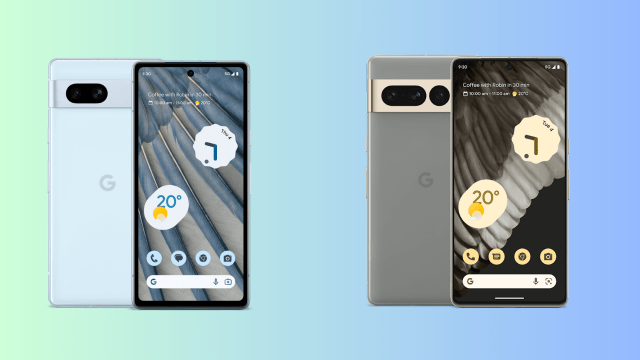It’s the day of Google I/O, and in the early hours of the morning, Google revealed a tonne of new things, including a tablet, a foldable (that’s not coming to Australia), AI stuff and a budget version of the Pixel 7 Pro called the Pixel 7a – and I love it.
Here are five reasons you should consider the Google Pixel 7a over its more powerful brother, the Pixel 7 Pro.
Google Pixel 7a vs Pixel 7 Pro: Which phone should I buy?
Here we’re comparing a budget handset to one of the best smartphones in the world right now, but as Gizmodo Australia’s Asha Barbaschow wrote in her review of the new handset:
“The only thing holding me back from swapping out the Google Pixel 7 Pro for the 7a as my main Android phone is its size. On an equally superficial level is the fact I prefer what the 7 Pro looks like, and I also consider it important to have on me the top-tier phone from Apple and the top-tier phone on me from Google, at all times for content reasons. It’s very likely none of this is what you’d consider.”
And this I agree with completely, except I’ve just gone and replaced my Pixel 7 Pro with a Pixel 7a. There’s not much I miss about the Pixel 7 Pro, so here are some reasons you may want to consider downgrading from your device too:
1. It’s quite cheap
The Pixel 7a is available in Australia at $750, whereas the Pixel 7 Pro, the most powerful phone in the Australian Google phone range (and most expensive) starts at $1,299. That’s quite a price difference between them, and I certainly think this is something to keep in mind if you’re trying to spend less but want a phone that feels good to use anyway.
2. It feels like a premium phone
The Pixel ‘a’ series has always been particularly good at feeling premium at a low price, but the Pixel 7a is definitely the best example yet. Compared to the $999 Pixel 7, the 7a has many of the same features, except for HDR, the same IP rating (IP67 instead of IP68) Gorilla Glass Victus, and Battery Share, to name a few features.
Possibly the thing that makes the Pixel 7a feel just so impressive is its refresh rate – 90hz, up from 60hz on the Pixel 6a and on par with the Pixel 7 (the 7 Pro has 120hz). This makes the screen look and feel smooth as you swipe and scroll between things on the screen.
3. It’s smaller
If you’re like me and love small phones then boy is the Pixel 7a for you. The Pixel 7a is one of the smaller premium-feeling phones on the market, being 152mm tall and 72.9mm wide, as opposed the Pixel 7, at 155.6mm tall and 73.2mm wide, and the Pixel 7 Pro at 162.9mm tall and 76.6mm wide.
Small phones are great because they don’t take up too much space in your pockets and they don’t feel too cumbersome in your hand, but I full accept that it’s not a particularly popular opinion to want smaller phones. To me, though, it’s certainly a perk.
4. The cameras rock
As you’ve likely seen in our review of the Google Pixel 7a, the cameras of the device are really good. While the Pixel 7 Pro still pulls off better snaps in some circumstances, such as in low-light environments or when zoom is important, the Pixel 7a stands its ground with a terrific array of lenses. Colour depth is deep and quality is high. I’m not particularly a camera snob, but the cameras on the Pixel 7a are perfect for my uses.
5. It’s almost as powerful
Wrapping things up, the Pixel 7a has the same processor as the Pixel 7 Pro – the Google-made Tensor G2 chip. Admittedly, the Pro is available with more storage capacity options (128GB, 256GB and 512GB) and greater RAM (8GB on the 7a, 12GB on the 7 Pro), but the Pixel 7a is just as capable for most consumer-level uses. It’s not until you start to work the device with higher-performance applications, such as more graphically intensive games, that you’re likely to notice a difference.
Bottom line: you should absolutely consider the Google Pixel 7a; not just as an alternative to the Pixel 7 and 7 Pro, but as a premium phone on its own.
You can catch up on the rest of Google’s I/O 2023 announcements here.
